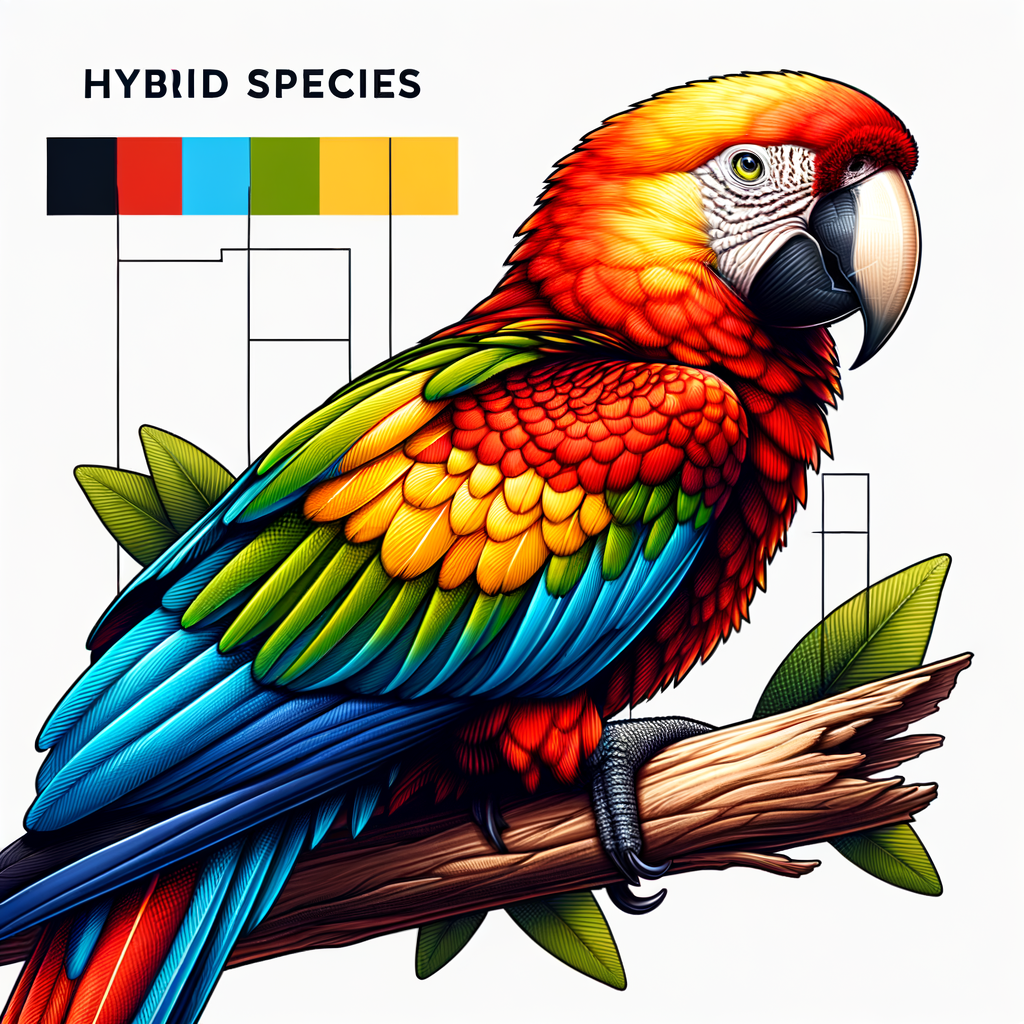
Introduction to the Catalina Macaw
The Catalina Macaw, a vibrant and captivating bird, is a hybrid species that has captured the hearts of bird enthusiasts around the world. This post will provide an overview of the Catalina Macaw and discuss why it is considered a charismatic macaw.
- Overview of the Catalina Macaw
- Why the Catalina Macaw is considered a charismatic macaw
The Catalina Macaw is a crossbreed between the Blue-and-Gold Macaw and the Scarlet Macaw. This bird is known for its stunning appearance, with a mix of vibrant colors that include blue, gold, green, and red. The Catalina Macaw is medium to large in size, with an average length of 34 inches from the beak to the tip of the tail feathers. They have a lifespan of up to 60 years, making them a long-term companion for those who choose to keep them as pets.
The Catalina Macaw is often referred to as a charismatic macaw due to its playful and affectionate nature. These birds are known for their intelligence and ability to mimic human speech, which adds to their appeal. They are also very social creatures, often forming strong bonds with their human caregivers. Their vibrant colors and striking appearance, combined with their lively personalities, make the Catalina Macaw a truly charismatic bird.
Understanding the Catalina Macaw’s unique characteristics and behaviors can help potential owners provide the best care for these beautiful birds. Stay tuned as we delve deeper into the fascinating world of the Catalina Macaw in the following sections.
The Debate: Hybrid vs Unique Species
When it comes to understanding the world of animals, one of the most interesting debates revolves around the concept of hybrid and unique species. Let’s delve into the fascinating world of hybrid species first.
Understanding Hybrid Species
A hybrid species is a result of the interbreeding between two animals of different species or subspecies. This interbreeding often results in an offspring that possesses characteristics of both parent species. Now, let’s break this down further.
- Definition of a hybrid species: A hybrid species is an organism that is born from the mating of two different species or subspecies. This means the parents are from two different types of animals, but they are closely related enough to have children together. The resulting offspring, or hybrid, has traits from both of its parents.
- Examples of other hybrid species: There are many examples of hybrid species in the world. Some of the most well-known include the mule (a cross between a donkey and a horse), the liger (a cross between a lion and a tiger), and the Catalina Macaw (a cross between a Blue-and-Gold Macaw and a Scarlet Macaw). These hybrids often possess unique characteristics that make them stand out.
Understanding hybrid species helps us appreciate the diversity and complexity of life on Earth. It reminds us that nature is full of surprises and that there’s always something new to learn and discover.
Understanding Unique Species
Let’s dive deeper into the world of unique species. These are species that are not a product of cross-breeding. They are original and have distinct characteristics that set them apart from others.
- Definition of a Unique Species
- Examples of Unique Species
- The Giant Panda: This is a unique species found only in China. They are known for their black and white fur and love for bamboo.
- The African Elephant: The largest land animal on earth, the African Elephant is a unique species. They are known for their large ears and long tusks.
- The Blue Whale: The Blue Whale is the largest animal ever to have lived on earth. They are a unique species found in all the world’s oceans, except the Arctic.
A unique species is a group of living organisms that share the same structure and can reproduce with each other. They are not a result of hybridization. This means they are not a mix of two different species. They have their own unique features and behaviors that make them stand out.
There are countless unique species in the world. Let’s take a look at some examples:
Understanding unique species helps us appreciate the diversity of life on earth. Each species plays a vital role in the ecosystem, contributing to the balance of nature.
Catalina Macaw Characteristics
The Catalina Macaw is a fascinating bird with a unique set of characteristics. Let’s explore these characteristics in detail.
- Physical traits of the Catalina Macaw
The Catalina Macaw is a hybrid bird, resulting from the cross-breeding of a Scarlet Macaw and a Blue-and-Gold Macaw. This gives the Catalina Macaw a striking appearance. They typically measure between 30 to 34 inches from the beak to the tip of the tail feathers, making them one of the larger macaw species. Their weight ranges from 2 to 3 pounds.
Their plumage is a vibrant mix of colors. The chest and belly are usually orange or red, while the wings can be a mix of blue, green, and yellow. Their large beak is strong enough to crack the toughest nuts and seeds.
- Behavioral traits of the Catalina Macaw
Catalina Macaws are known for their playful and intelligent nature. They are social birds that enjoy the company of their human families and other birds. They are also known to be quite vocal, with a range of squawks and screams that they use to communicate.
These birds are also highly trainable, capable of learning a variety of tricks and commands. They have even been known to mimic human speech, although not as extensively as some other parrot species.
- Unique traits that set the Catalina Macaw apart from other macaw species
What sets the Catalina Macaw apart from other macaw species is its hybrid origin. This hybridization results in a bird that has the best traits of both parent species. For example, they have the vibrant colors of the Scarlet Macaw and the gentle temperament of the Blue-and-Gold Macaw.
Another unique trait is their lifespan. Catalina Macaws can live up to 60 years, which is longer than many other macaw species. This long lifespan makes them a lifelong companion for those who choose to keep them as pets.
In conclusion, the Catalina Macaw is a unique and fascinating bird, with a mix of physical and behavioral traits that make it stand out among other macaw species.
Origin of the Catalina Macaw
The Catalina Macaw is a fascinating bird with a rich history and a unique geographical origin. Let’s dive deeper into the historical background and geographical origin of this beautiful creature.
- Historical background of the Catalina Macaw
The Catalina Macaw is not a naturally occurring species. It is a hybrid bird, a result of crossbreeding between the Blue-and-Gold Macaw and the Scarlet Macaw. This hybridization process started in captivity in the late 20th century. The aim was to create a bird that possessed the best traits of both parent species. The beauty, intelligence, and friendly nature of the Catalina Macaw quickly made it a popular choice among bird enthusiasts and pet owners.
- Geographical origin of the Catalina Macaw
As a hybrid, the Catalina Macaw does not have a natural geographical origin. It is not found in the wild. The parent species, however, have distinct geographical origins. The Blue-and-Gold Macaw originates from South America, specifically regions spanning from Panama to Paraguay. The Scarlet Macaw, on the other hand, is native to Central and South American rainforests. The Catalina Macaw, being a product of these two species, carries the genetic heritage of these diverse regions.
In conclusion, the Catalina Macaw is a testament to the wonders of hybridization. It carries the historical legacy of two distinct species and the geographical heritage of diverse regions. This beautiful bird, with its vibrant colors and friendly nature, continues to captivate bird lovers around the world.
Catalina Macaw Behavior
The Catalina Macaw, a hybrid bird that is a mix of the Blue and Gold Macaw and the Scarlet Macaw, is known for its vibrant colors and unique behavior. In this section, we will delve into the behavior of the Catalina Macaw, particularly its interactions with other macaw species.
Interactions with Other Macaw Species
Understanding the behavior of the Catalina Macaw in relation to other macaw species can provide valuable insights into their social dynamics and compatibility.
- How the Catalina Macaw interacts with other macaw species
- Comparing the behavior of the Catalina Macaw to other macaw species
The Catalina Macaw, like most macaws, is a social bird. They enjoy the company of their own kind and can often be seen interacting with other macaw species. They are known to be playful and engaging, often participating in mutual preening and shared playtime. However, it’s important to note that each bird is an individual and interactions can vary based on personality and past experiences.
Compared to other macaw species, Catalina Macaws are known to be more sociable and less aggressive. They are also known for their intelligence and curiosity, often showing a greater interest in their surroundings than other species. However, they can also be more demanding of attention and require more mental stimulation to keep them happy and healthy.
In conclusion, while the Catalina Macaw shares many behavioral traits with other macaw species, it also has its own unique characteristics. Understanding these behaviors can help in providing the best care and environment for these beautiful birds.
Interactions with Humans
When it comes to the Catalina Macaw, their interactions with humans are quite intriguing. These birds are known for their friendly nature and intelligence, which makes them popular pets. Let’s delve deeper into their behavior around humans and how to interact with them properly.
- The Catalina Macaw’s behavior around humans
- How to properly interact with a Catalina Macaw
- Respect their space: While Catalina Macaws are social, they also value their space. Avoid forcing interaction and allow the bird to come to you when they feel comfortable.
- Use a calm voice: These birds respond well to calm and gentle voices. Loud or aggressive tones may scare them.
- Offer treats: Treats can be used as a positive reinforcement to encourage interaction and build trust.
- Provide mental stimulation: Catalina Macaws are intelligent birds that require mental stimulation. Interactive toys and puzzles can keep them engaged and happy.
The Catalina Macaw is a social bird that thrives on interaction and companionship. They are known to form strong bonds with their human caretakers. These birds are also known for their playful nature and love for attention. They enjoy being part of family activities and are often seen mimicking human speech and sounds. However, it’s essential to remember that each bird is an individual and may exhibit different behaviors.
Interacting with a Catalina Macaw requires patience and understanding. Here are some tips:
Understanding the Catalina Macaw’s behavior and knowing how to interact with them can lead to a rewarding and enriching experience for both the bird and the human. Remember, every bird is unique, and what works for one might not work for another. Patience and consistency are key when building a relationship with these beautiful creatures.
Conclusion: Is the Catalina Macaw a Hybrid or Unique Species?
- Summary of the evidence for and against the Catalina Macaw being a hybrid species
The Catalina Macaw has long been a subject of debate among bird enthusiasts and scientists alike. On one hand, there’s strong evidence to suggest it’s a hybrid species. This is primarily because the Catalina Macaw shares physical characteristics with both the Blue-and-Gold and the Scarlet Macaw, which are its parent species. It has the vibrant coloration of the Scarlet Macaw and the size and temperament of the Blue-and-Gold Macaw. On the other hand, some argue that these shared traits could simply be a result of convergent evolution, where different species independently evolve similar traits. - Summary of the evidence for and against the Catalina Macaw being a unique species
Those who believe the Catalina Macaw is a unique species point to its distinct behavior and vocalizations, which are different from both parent species. They also note that Catalina Macaws can breed with each other, producing fertile offspring, a characteristic typically associated with unique species. However, skeptics argue that these differences aren’t enough to classify the Catalina Macaw as a unique species, especially considering its clear genetic ties to the Blue-and-Gold and Scarlet Macaws. - Final thoughts on the Catalina Macaw’s classification
The classification of the Catalina Macaw is a complex issue with valid arguments on both sides. While it’s clear that the Catalina Macaw shares traits with its parent species, it also exhibits unique characteristics that set it apart. As such, it’s difficult to definitively classify the Catalina Macaw as either a hybrid or a unique species without further research. Regardless of its classification, one thing is clear: the Catalina Macaw is a fascinating and beautiful bird that continues to captivate bird lovers around the world.






